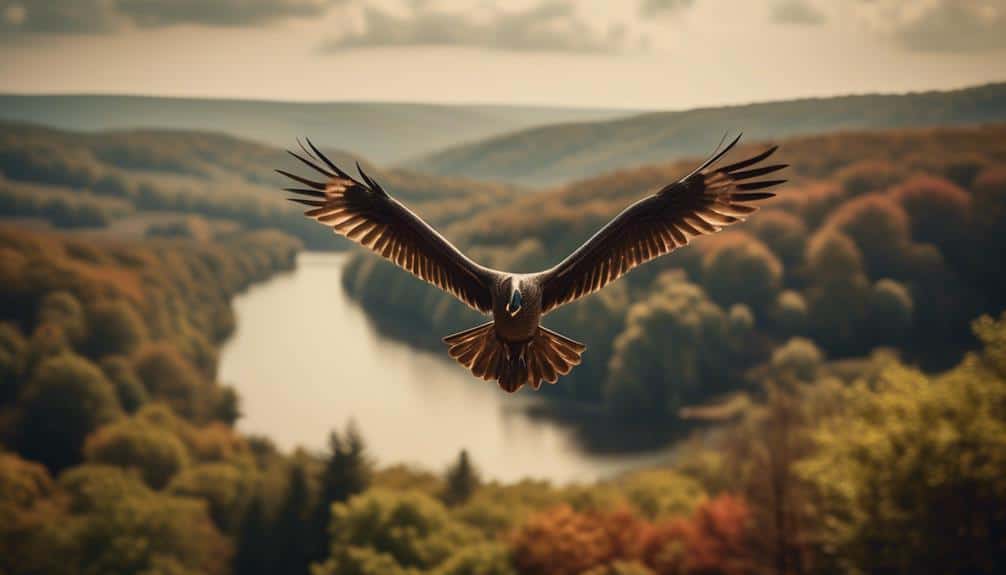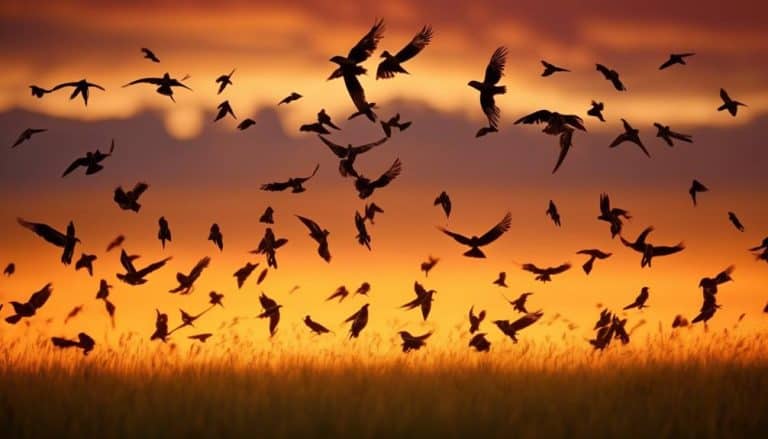As I stepped into the lush, verdant forests of Pennsylvania, a symphony of wings and calls enveloped me, beckoning me to explore the realm of large birds that call this state home.
From the majestic Bald Eagles soaring high above, their piercing gaze commanding respect, to the elegant Blue Herons gracefully wading through the tranquil waters, Pennsylvania boasts a diverse array of avian wonders.
However, it is not just the size and beauty of these creatures that captivates me; rather, it is their unparalleled ability to adapt and thrive in this ever-changing landscape.
Join me as we embark on a journey to discover the remarkable stories and extraordinary lives of the large birds of Pennsylvania.
Bald Eagles
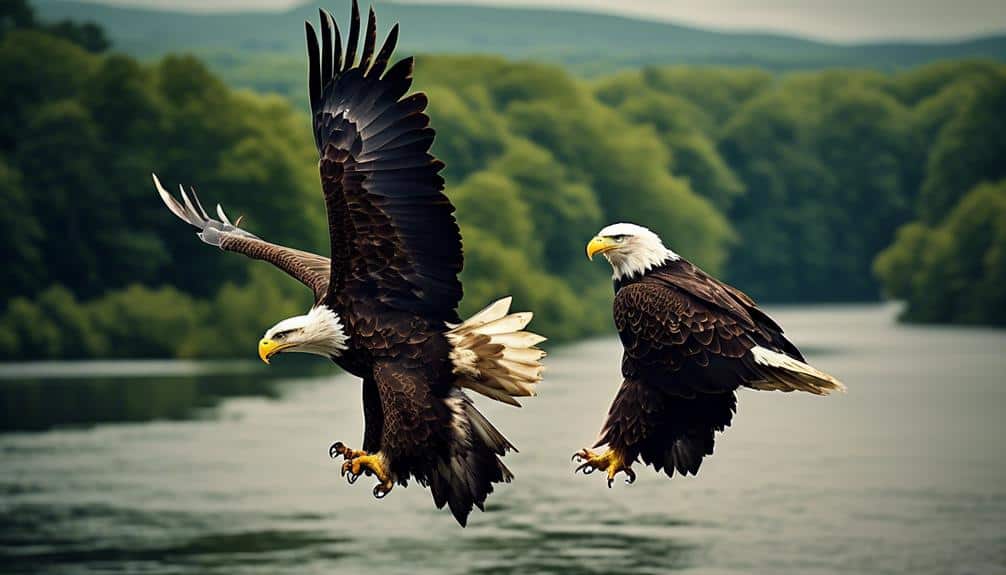
Bald Eagles, the majestic and powerful birds of prey, are a prominent species found in Pennsylvania. These magnificent creatures have long been a symbol of strength and resilience.
Conservation efforts have played a vital role in the recovery of the Bald Eagle population in Pennsylvania, as the species was once on the brink of extinction.
One key aspect of Bald Eagle conservation is the protection of their nesting habitats. Bald Eagles typically build their nests in tall trees near bodies of water, such as rivers or lakes. These nests, known as aeries, are massive structures made of sticks and lined with soft materials. Conservationists work tirelessly to safeguard these nesting sites, ensuring that they remain undisturbed and free from human interference.
Another important conservation effort is the monitoring of Bald Eagle populations. This involves regular surveys to assess their numbers and breeding success. By closely monitoring nesting habits and tracking the number of fledglings, researchers can gain valuable insights into the health and stability of the population.
Conservation efforts and the protection of nesting habitats have been crucial in the recovery of Bald Eagles in Pennsylvania. Through these initiatives, these iconic birds have made a remarkable comeback, demonstrating the positive impact of conservation on endangered species.
Blue Herons
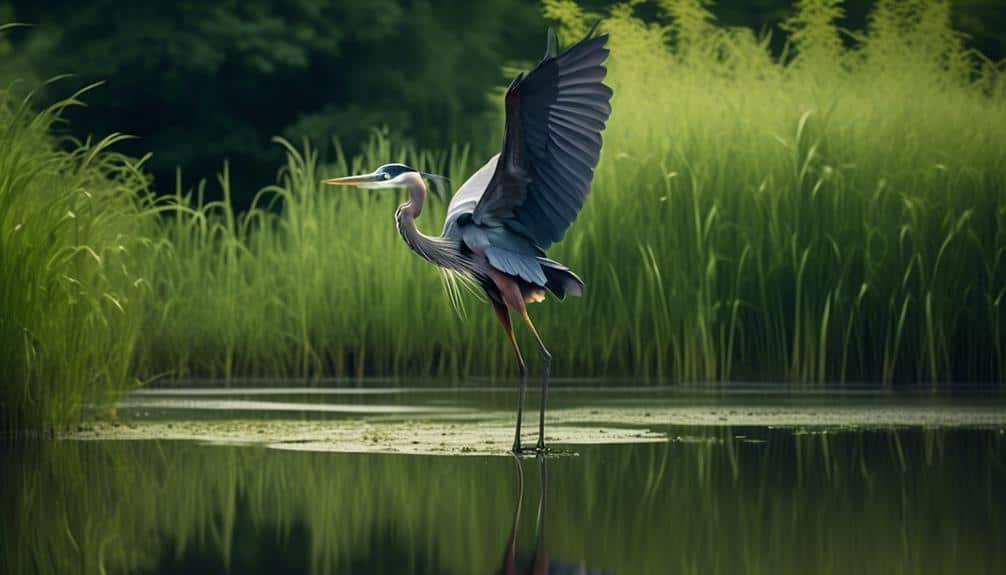
Blue Herons, also known as Great Blue Herons, are magnificent wading birds commonly found in Pennsylvania. These elegant creatures, with their long legs and graceful necks, are a sight to behold in the wetlands and marshes of the state. Blue herons are known for their striking blue-gray plumage, which sets them apart from other heron species.
Blue herons can be found in a variety of habitats, including freshwater and saltwater marshes, lakes, ponds, and rivers. They prefer areas with shallow water, as it allows them to easily hunt for prey such as fish, frogs, and small mammals. Their long, sharp beaks are perfect for catching and impaling their prey.
Conservation efforts have been put in place to protect the blue heron population in Pennsylvania. These efforts include habitat preservation and restoration, as well as monitoring and research to better understand their populations and behaviors. The Pennsylvania Game Commission and other organizations work together to ensure the long-term survival of these magnificent birds.
To further illustrate the characteristics of blue herons, here is a table showcasing their physical attributes:
| Physical Attribute | Description |
|---|---|
| Length | 38-54 inches |
| Wingspan | 66-79 inches |
| Weight | 4.6-7.3 pounds |
| Plumage Color | Blue-gray with a white head and black stripe above the eye |
Blue herons are a vital part of Pennsylvania's ecosystem, and efforts to protect their habitats and conserve their populations are crucial for the overall health of the state's biodiversity.
Peregrine Falcons
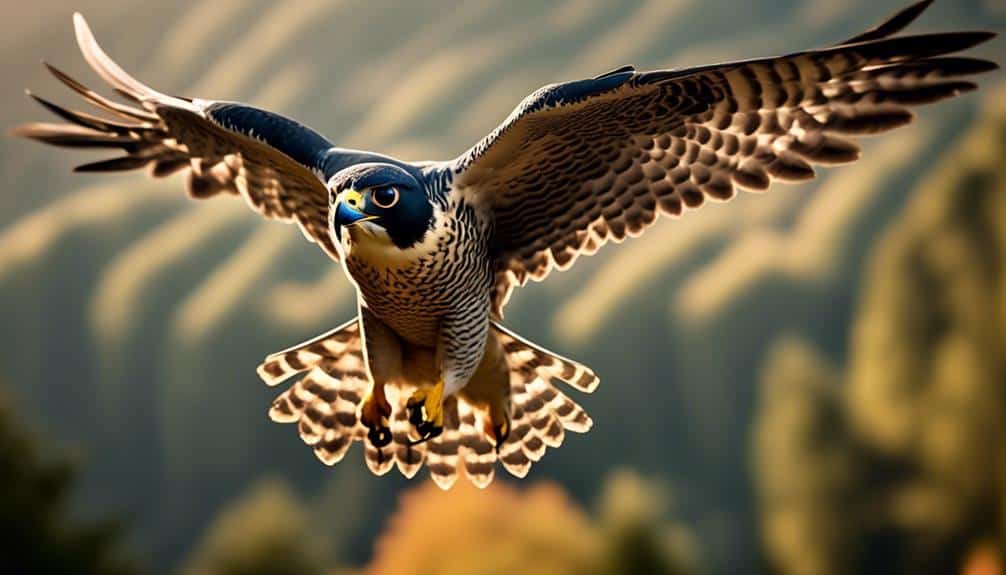
Peregrine Falcons, known for their incredible speed and agility, are a prominent species of birds found in Pennsylvania. These majestic birds are known to undertake long and impressive migratory journeys, covering vast distances as they move between their breeding and wintering grounds.
Here are some key facts about Peregrine Falcons in Pennsylvania:
- Peregrine falcon migration: Peregrine Falcons are highly migratory birds, traveling thousands of miles each year. They breed in the northern parts of the United States and Canada, and during the winter months, they migrate south to warmer regions, including Pennsylvania. Their migration routes can span from the Arctic tundra to South America.
- Peregrine falcon conservation efforts: Due to the decline in their population caused by the use of pesticides, Peregrine Falcons were listed as an endangered species in 1970. Thanks to extensive conservation efforts, including captive breeding and reintroduction programs, their numbers have recovered significantly. Organizations like the Pennsylvania Game Commission and the Peregrine Fund work tirelessly to monitor and protect these birds.
- Reintroduction in Pennsylvania: Peregrine Falcons were successfully reintroduced to Pennsylvania in the 1980s after being extirpated from the state in the 1960s. Special nesting platforms and artificial structures were erected to provide suitable habitats for the falcons. Today, these efforts have paid off, and Peregrine Falcons can be observed nesting on bridges, tall buildings, and other structures throughout the state.
- Their hunting prowess: Peregrine Falcons are renowned for their hunting skills. With their remarkable speed, they can reach speeds of up to 240 miles per hour during their hunting dives, or 'stoops.' They primarily feed on small to medium-sized birds, intercepting them mid-flight with their sharp talons.
Great Blue Herons
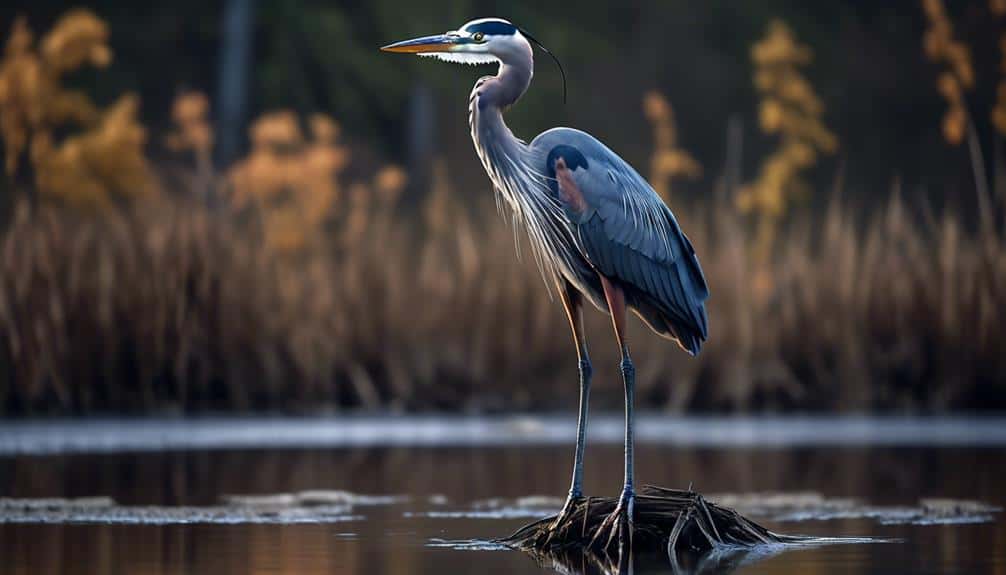
After exploring the impressive migratory journeys and hunting prowess of the Peregrine Falcons, it's now time to shift our focus to another captivating species of large birds found in Pennsylvania: the Great Blue Herons.
These majestic birds, scientifically known as Ardea herodias, are a common sight in Pennsylvania's wetlands, rivers, and lakes. Great Blue Herons are the largest herons in North America, standing at an impressive height of 4 feet and boasting a wingspan of up to 6 feet. Their plumage is predominantly blue-gray, with a distinctive black stripe running along their crown and a long, dagger-like bill. These birds are highly adaptable and can be found in a wide range of habitats, including freshwater and saltwater environments.
The Great Blue Heron is a patient and skilled hunter, known for its ability to stand still for long periods of time while waiting for prey. With its sharp eyesight and quick reflexes, it can catch a variety of aquatic creatures, including fish, frogs, and small mammals. It uses its long neck and sharp bill to strike swiftly and accurately, making it a formidable predator.
In Pennsylvania, Great Blue Herons play an important role in maintaining the ecological balance of wetland ecosystems. Their presence indicates the overall health of these habitats, as they rely on clean water and abundant food sources to thrive. These magnificent birds are truly a treasure of Pennsylvania's bird species, captivating both scientists and nature enthusiasts alike with their grace and beauty.
Ospreys

How do Ospreys adapt to their unique hunting environment?
Ospreys, also known as fish hawks, are magnificent birds of prey that have evolved remarkable adaptations to thrive in their hunting environment. Here are some ways in which Ospreys adapt to their unique habitat:
- Sharp, curved talons: Ospreys have sharp, curved talons that allow them to grip slippery fish with ease. Their strong grip ensures that their prey doesn't slip away during flight.
- Reversible outer toes: One of the most fascinating adaptations of Ospreys is their reversible outer toes. This adaptation enables them to have a firm grasp on their catch while flying, ensuring a secure hold on their slippery prey.
- Elongated wings: Ospreys have long, narrow wings that aid in efficient flight. These wings allow them to soar effortlessly above the water, searching for fish below.
- Nesting behavior: Ospreys exhibit interesting nesting behavior. They build large nests, called eyries, on top of tall structures such as trees, cliffs, or even man-made structures like utility poles. These nests are often reused year after year, contributing to Osprey conservation efforts.
Understanding the unique adaptations and nesting behavior of Ospreys is crucial for their conservation. By studying these remarkable birds, we can ensure the preservation of their habitats and continue to marvel at their extraordinary hunting skills.
Sandhill Cranes
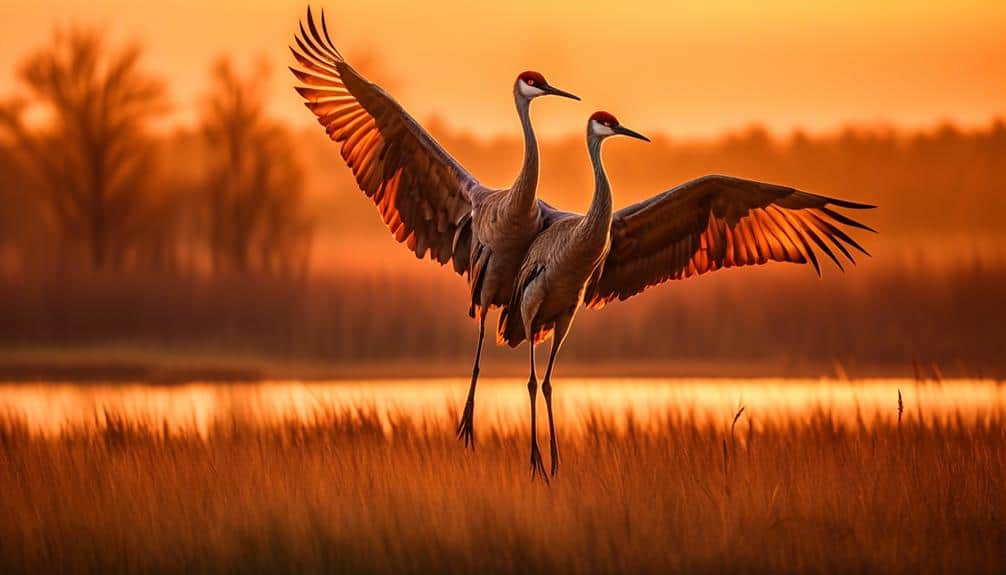
Sandhill Cranes, renowned for their distinctive trumpeting calls, are large migratory birds that exhibit fascinating behaviors and possess unique physical adaptations. These birds are known for their majestic appearance, with a height of up to four feet and a wingspan of almost seven feet. The Sandhill Crane's mating rituals are truly remarkable. They engage in elaborate dances, leaping high into the air, flapping their wings, and tossing vegetation. These displays help establish and strengthen pair bonds.
Migration is a key aspect of the Sandhill Crane's life cycle. In North America, they undertake long-distance journeys, traveling from their breeding grounds in the northern United States and Canada to their wintering grounds in the southern United States. These migration patterns are guided by a combination of genetic programming and environmental cues, such as temperature and food availability.
During migration, Sandhill Cranes fly in V-shaped formations, taking advantage of the aerodynamic benefits of flying in a group. This allows them to conserve energy and increase their flight range. Additionally, these birds are known for their ability to fly at high altitudes, reaching heights of up to 10,000 feet during migration.
Frequently Asked Questions
How Do Large Birds in Pennsylvania Contribute to the Local Ecosystem?
Large birds in Pennsylvania play a crucial role in the local ecosystem. They contribute to the biodiversity by dispersing seeds, controlling populations of small animals, and serving as indicators of ecosystem health.
What Are the Main Threats and Conservation Efforts for Large Birds in Pennsylvania?
The main threats to large birds in Pennsylvania include habitat loss and fragmentation, collisions with man-made structures, and climate change. Conservation efforts focus on protecting and restoring habitats, implementing bird-friendly practices, and raising awareness about the importance of these birds.
Can Large Birds in Pennsylvania Be Found in Urban Areas or Are They Mostly Restricted to Rural Habitats?
Large birds in Pennsylvania can be found in both urban and rural habitats. Their presence in urban areas can have a significant impact on agriculture due to their foraging habits and potential damage to crops.
Are There Any Specific Regulations or Laws in Place to Protect Large Birds in Pennsylvania?
There are regulations and laws in place to protect large birds in Pennsylvania. These measures ensure their safety and preservation. It is important to follow these guidelines to maintain the well-being of these magnificent creatures.
How Do Large Birds in Pennsylvania Differ in Terms of Behavior and Habitat Preferences?
Behavior patterns and nesting preferences of large birds in Pennsylvania vary depending on the species. Some prefer open habitats for foraging, while others nest in dense forests. Understanding these differences is crucial for their conservation and management.
Conclusion
After extensively researching large birds in Pennsylvania, it's fascinating to note that the population of Bald Eagles has experienced a remarkable recovery in recent years.
In 1983, there were only three nesting pairs in the state, but by 2019, this number had skyrocketed to 300 nests. This incredible resurgence demonstrates the success of conservation efforts and highlights the importance of protecting these majestic creatures and their habitats for future generations.

